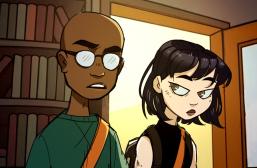Animated Characters Who Need Therapy

Therapy is a universal urgency covering all forms of life, however the obstacles are extensive for the conventional non-human species.
The Duck
Daffy Duck has a long work history in animation, the type of character with job stability in any economic climate. He is a legend predominantly due to his endless tenacious identities that increased throughout his career. In the famous piano scene from Who Framed Roger Rabbit, the shamefaced duck fiercely competes with long time co-worker Bugs Bunny.
Type A individuals tend to be very competitive and self-critical. They strive toward goals without feeling a sense of joy in their efforts or accomplishments. Inter-related with this is the presence of a significant life imbalance. This is characterized by a high work involvement. Type A individuals are easily ‘wound up’ and tend to overreact. They also tend to have high blood pressure (hypertension). [1]
This lifestyle is ingrained in Daffy, deeming it improbable for him to realize any complication. Unfortunately, this type of mental predicament will be overlooked by the one experiencing it and untreated in most cases. Daffy’s failure of self-acknowledgment works well for the casting directors who have manipulatively convinced Daffy of their true friendship and loyalty. Rest assured that if said duck sought out professional help or took advice from a Dr. Phil book, he would quickly find himself exempt from casting director camaraderie.
The Motherless Fawn
Conversely, Bambi is a cute, sweet, vulnerable fawn. He started life with his mother who had the capacity of winning any “mother of the year” award on any talk show, every year, only to experience the loss of her life.
Let’s play devil’s advocate to examine the possible logic behind Bambi’s delicious persona. Don’t forget, it’s always the nicest personality that ends up on the news. Typically the neighbors are interviewed, shocked yet delighted to have camera time, with their “say it ain’t so” comments. Bambi not only lives his life without his mother but the cause of her death was a deplorable tragedy derived from hideous intentions of deer hunters. This particular fawn, in my unprofessional opinion, suffers from untreated PTSD. The grace card is possibly a defense mechanism.
Post-Traumatic Stress Disorder (PTSD) is an anxiety disorder that may develop after exposure to a terrifying event or ordeal in which severe physical harm occurred or was threatened. [2]
Bambi is the perfect candidate for Primal Therapy. At the risk of sounding absurd, this therapy forces the victim to relive the trauma and express the pain perhaps aggressively. Many cultural icons such as John Lennon, James Earl Jones and Roger Williams dabbled in Primal Therapy however this was nothing more than a 1970’s fad, like pet rocks.
Primal Therapy is a trauma-based psychotherapy created by Arthur Janov, who argues that neurosis is caused by the repressed pain of childhood trauma.
The Dad

Homer Simpson, donut lover/self-made success in animation history, has an outstanding career yet he retains a fundamental loss of self-worth. Regardless, Homer never cries uncle in the midst of ensuing his foolish ideas ending in perpetual disastrous fallout. Constant failure can quite possibly lead to general feelings of emasculation and anxiety. It is possible Homer suffers from the “Dunning-Kruger effect”.
As David Dunning and Justin Kruger of Cornell University[3][4] conclude, “the miscalibration of the incompetent stems from an error about the self, whereas the miscalibration of the highly competent stems from an error about others” [3]
The phenomenon was first tested in a series of experiments published in 1999 by David Dunning and Justin Kruger of the Department of Psychology, Cornell University.[3][4] The study was inspired by the case of McArthur Wheeler, a man who robbed two banks after covering his face with lemon juice in the mistaken belief that, as lemon juice is usable as invisible ink, it would prevent his face from being recorded on surveillance cameras. [4]
Homer may lack the minimum IQ required to successfully produce positive results, of any kind, from him foolish ideas but that doesn’t explain his feeble food eating regulation. Most individuals, including me, would eat non-stop donuts if the consequences weren’t there. To sum it up, Homer is not capable of creating a crystal ball in his mind when executing his ideas and we are living vicariously through him.
Pure Evil

Unlike Homer, not because of donut reasons, Judge Claude Frollo is a self-loving, intimidating, know it all. If Frollo were a part of one’s life, in any capacity, they would undeniably feel apprehensive about playing racket ball within miles of him.
Wanting and insisting on getting your own way is a set up for unhappiness. Rigidity in thinking leads to power struggles or submission from others and distancing. As Andre’ Maurois said, “Everything that is in agreement with our personal desires seems true. Everything that is not puts us in a rage. [5]
Frollo is pure; self justified evil with a career in government, permitting him endless power. He can kill a man as easy as you or I can smash a mosquito with a hasty clap of the hands. The likelihood of change in Frollo’s personality type is rare due to his solid belief in self. We can safely blame Frollo for The Real Housewives brand as it would take extensive work to adjust this mentality alongside a therapist with a personal punishment agenda. People are nice to Frollo only because they fear him. Characters like Frollo might love their life when the spotlight is shining on them but that spotlight doesn’t shine when he’s alone, very much alone. The truth is, people who suffer from Frollo’s personality type find themselves on their own when they need tea with honey for their sore throat and in the back of a cab to pick up their luxury SUV from the mechanic. When you see someone driving a fancy crossover, realize they might be struggling with mental battles in their head regardless of the lovely smelly leather smell and the restricted or endangered wood veneered steering wheel.
Transparency International has done exceptionally remarkable work in creating worldwide awareness about the dangerous implication of the growing menace of corruption, especially for billions of people living in developing countries. [6]
The Consistent Hat Wearer
The Man With The Yellow Hat is a complex candidate for proper subjective diagnosis.

A tall, moderately dapper, fellow residing in a high-rise on the upper east side with his long time significant other monkey, George. The two individuals frequently travel together to their vacation home outside the city. Regardless of the location they always find themselves involved in an unexpected adventure. There are two issues regarding the man with the yellow hat that lead to a possible flaw in his personality.
1: He is constantly involved in drama caused by George. Although you will never see the man lose his patients with the monkey, despite the incessant catastrophes George innocently causes, one has to wonder how the man with the yellow hat reacts when the cameras aren’t rolling. His capacity to accept and tolerate the monkey business George brings to the table is unrealistic.
2: The man with the yellow hat has yet to let an individual of his own species get to know him very well. He is a master at hiding this red flag from every person who has come in contact with him.
“Conformity is a very basic feature of human sociality. It retains in- and out-groups, it helps groups coordinate and it stabilizes cultural diversity, one of the hallmark characteristics of the human species,” says psychological scientist and lead researcher Daniel Haun of the Max Planck Institute for Evolutionary Anthropology and the University of Jena.
The man with the yellow hat simply avoids his genetic predisposition to contribute to society.
“Though the use of bearskins in London today is purely ceremonial and traditional, the wearing of tall hats in battle has been used by many people around the world as a form of psychological warfare. The warriors appear taller than they really are in order to intimidate. This, together with war cries, rhythmic beating on shields, etcetera is simply done to weaken the morale of the other side.” Yaarbiriah, member of funtrivia.com
In defense of the man with the yellow hat, he has never come close to any sound resembling a war cry and hasn’t rhythmically beaten on a shield.
Approximately 25 percent of shoplifters are kids, 75 percent are adults. 55 percent of adult shoplifters say they started shoplifting in their teens. [7]
There is no reason to think the man with the yellow hat is a shoplifter however it is very interesting information.
Conclusion
We can confidently bet on the angry, self-centered, moronic, passive aggressive and evil personality type to have consistent success in show business. The problem with actors who only have restaurant industry experience on their resumé is not necessarily a lack of talent but the absence of a fundamental distorted brain. Regarding animated stories, the studios cater to typically young children viewers that apparently love watching, playing with and wearing on their clothing, a character with moderate to severe personality disorder. We have to wonder if the “train wreck” phenomena is a natural part of our genetic make-up.
Works Cited:
3: Kruger, Justin; Dunning, David (1999). “Unskilled and Unaware of It: How Difficulties in Recognizing One’s Own Incompetence Lead to Inflated Self-Assessments”. Journal of Personality and Social Psychology 77 (6): 1121–34. doi:10.1037/0022-3514.77.6.1121. PMID 10626367. CiteSeerX: 10.1.1.64.2655.
5: From the book The “I Need To Be Right” Way of Thinking author: Lynne Namka, Ed. D.
6: CORRUPTION: A PSYCHOSOCIAL ISSUE author: Niranjan Prasad Upadhyay
7: National Association For Shoplifting Prevention
What do you think? Leave a comment.











Frollo’s disturbing psychology is what made him so compelling and terrifying for me growing up. His song, “Hellfire” in particular is brilliant in that he paints himself so tragically when really he’s disgusting and disturbing.
Thank you Jemarc, good feedback! I love how he sings “It’s not my fault, I’m not to blame” It’s textbook!!
Lauren,
Great piece on animation and pyschology. I think your line about Daffy is pretty applicable to many of us “Daffy’s failure of self-acknowledgment.”
Thanks Venus 🙂 and yes, unfortunately you are right!
I love articles that use psychology terms to describe a fictional characters actions. Nice article.
Thank you!
Many of these conditions are not treatable by psychiatrists.
Many of them would never see one.
Such a funny post!
🙂 Thank you
love some of the choices
Thank you 🙂
Hilarious. Funny how so many stories (maybe all stories) seem to depend on some sort of apparent emotional disorder. They make the most interesting characters, I guess!
Poor Bambi. 🙁
What a fun article! I really like your diagnosis of Frollo It really shows why he’s such fantastic villain. Well done!
*LOL* You had fun with this one while at the same time giving a lesson in psychology. Kudos to you
~Constellation
Judge Claude Frollo is easily one of Disney’s greatest and most evil villains, despite being ‘human’. Him being voiced by the late Tony Jay only added to how great a villain he was. His death is really awesome too.
If I were casting a live-action version of this film, I would cast either Jeremy Irons or Daniel Day Lewis as Frollo.
homer simpson embodies the essence of modern american man. he is the stereotypical male. he is also my idol.
He is what is called a schiester. I would be friends with him. 😉
This article is so interesting. It is quite humorous that the very reason why so many people love these characters is often correlated with what could be viewed as causing them to be in need of therapy. It makes me wonder about those people who are so popular in real life!
This was a really interesting article. I had fun reading it! I look forward to more articles from you 🙂
Of course frollo is the most frightful villain because he is too real/human and possibly the scariest villain in disney history!
I enjoy anything relating to psychology and found your article not only funny but pretty informative! Great work.
I like how you talked about Frollo and the Man with the Yellow Hat is probably borderline OCD. I never thought this way about Bambi before and I feel like I should have.
This was indeed a very fascinating article. I love how you took all these characters and psychoanalyzed all of them. Oh and I especially loved the bit about bambi. It was so insightful!
This is awesome and a pretty interesting prism to watch certain shows through. Cartoon Therapy sounds like it would be a solid Web series
I was hoping to hear a bit about social anxiety, a la Tina Belcher. Great article, nonetheless.
I liked the way you gripped the reader’s attention with memorable characters and your witty tone. Good job. The article was a fun read.
Loved the fun approach you took on this article!
Considering Frollo has no superpowers but he compensates for his cruelty and a warped sense of what’s good and evil. He only laughed once in the film. Frollo is one of my all time favorite villains asides from just being my favorite Disney villain.
The title itself made me laugh out loud! This was a hilariously great article. Good job!
Frollo is mad!
I laughed so hard I startled my coworker. Funny and intelligently written. Thank you for sharing!
Such an amusing article! Nice job.
Really interesting and funny article! You’ve managed to ally humour and cartoon to psychology and serious psychological/social issues. It show how cartoons reflect our society and our time, and always contain serious commentaries on humans and social life. I love it!
I like how you pulled characters from animation that most people wouldn’t go to first when thinking about psychological disorders. My go-to example for this particular topic is generally Belle from Beauty and the Beast with her Stockholm Syndrome.
The “invisible ink” story in reference to Homer’s condition sounds exactly like something he would do, minus robbing the bank.
Beavis and Buthead need therapy as well. Educational therapy, psychological therapy et cetera.